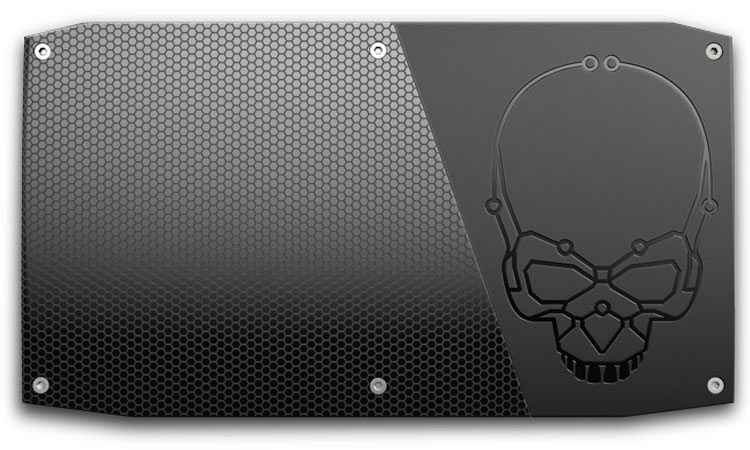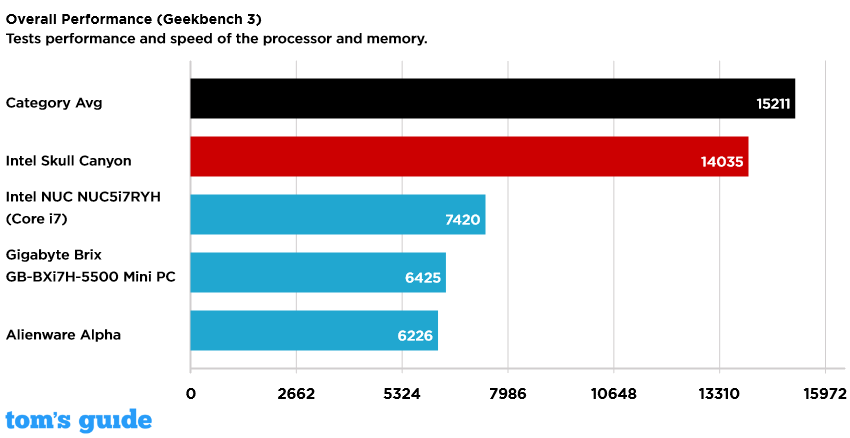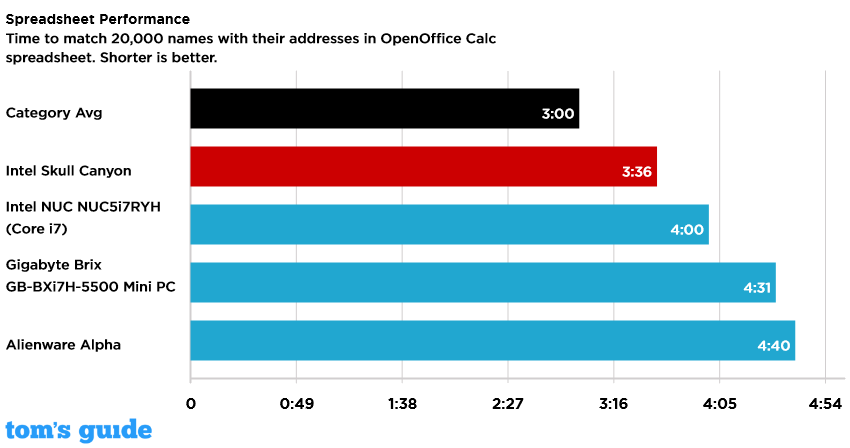Tom's Guide Verdict
The Intel Skull Canyon NUC offers speedy performance and can power multiple 4K displays, but it doesn't have much to offer serious gamers.
Pros
- +
Cool-looking portable design
- +
Freedom to add your own RAM, storage and OS
- +
Strong CPU performance
- +
Can power multiple 4K displays
Cons
- -
Poor gaming performance
- -
Pricey with necessary parts
- -
Not for casual users
Why you can trust Tom's Guide
The $650 Intel NUC6i7KYK (or Skull Canyon) is quite the confusing product. Its marketing materials and skull-laden design would have you believe it's a miniature gaming PC, but in reality, it's a portable workstation that can muster a handful of big PC games at low settings.
Fortunately, it does the workstation part quite well, with a speedy Core i7-6770HQ processor and Intel Iris Pro graphics that can power three 4K displays at once. However, integrated graphics will only take you so far in gaming, and the NUC fails to play mainstream games at respectable settings, unless you happen to have a pricey external GPU dock. This is also a bare-bones system, meaning only power users willing to supply their own RAM, storage and OS will want to use this impressive but fairly niche mini PC.
Design
Using the Skull Canyon NUC marks the first time I've thought to myself, "Wow, this Intel product looks badass." This black brick of a desktop seems like someone carved a VHS tape into a slim gaming PC, with honeycomb-like vents on the side and a large skull logo on the top just begging to be noticed by the Call of Duty crowd. If the skull is a bit much for you, the PC includes a more vanilla-looking faceplate that you can swap in.

At 8.3 x 4.6 x 1.1 inches and 1.4 pounds, the tiny NUC will all but disappear into your entertainment center or desk, and is more than light enough to throw in your bag on the way to a LAN party. It doesn't have the extra-compact, square-shaped design of mini PCs such as the Gigabyte Brix and the standard Intel NUC, but it's also slimmer than those models.
Ports
The NUC comes armed with enough ports for your mouse, keyboard, controller and even multiple monitors. The front of the PC offers instant access to an SD card slot, a headphone jack and two USB 3.0 ports. In the back, you'll find a rear speaker jack, an Ethernet port, an additional two USB 3.0 connections, a mini DisplayPort and an HDMI port.

The NUC also features a USB Type-C Thunderbolt port, which can connect to displays, speedy storage drives and, perhaps most importantly for gamers, external graphics card docks such as the $499 Razer Core. This means that, given the right setup, you could use a high-end Nvidia GPU with Intel's tiny PC. Also, if you have a USB-C-compatible monitor, you can hook the NUC up to as many as three 4K displays.
What's Included, What You'll Need
The $650 NUC is a bare-bones system, meaning you'll have to supply your own RAM, SSD and operating system. For review purposes, our NUC shipped with 16GB of Crucial 2133-MHz DDR4 memory (normally about $118) and a 512GB Samsung 950 Pro M.2 NVMe SSD (roughly $317).
We installed our own copy of Windows 10 Pro, which costs $199 for new users (Windows 10 Home is a cheaper $119). If you were to build our configuration yourself, you'd be paying about $1,284.
MORE: The Best Gaming Desktops Available Now
Regardless of which memory or storage you choose, the NUC features a 6th Generation Intel Core i7-6770HQ processor, Intel Iris Pro 580 graphics and two DDR4 RAM sockets that support up to 32GB of RAM.
Gaming Performance
Despite being billed as a gaming-ready mini PC, the Skull Canyon NUC performs more like a low-end laptop than a dedicated games machine. The desktop's integrated Intel Iris Pro 580 graphics chip was capable of handling a few high-end PC games, but only at settings so low they'd make even the most casual PC gamer cringe.
Rise of the Tomb Raider is normally one of the most gorgeous PC games around, but I had to dial the game down to a dull 720p at the lowest settings in order to get frame rates above 30 frames per second. The game's benchmark turned in a sluggish 24.96 fps at 1080p on low settings, but rose to a playable 38.03 fps at the expense of a low, 720p resolution.
Rise of the Tomb Raider is normally one of the most gorgeous PC games around, but I had to turn the graphics down in order to play at 30 frames per second.
Intel's mini PC told a similar story when running the tactical shooting action of Rainbow Six Siege. On the game's benchmark, the NUC churned out a just-barely playable 30.9 fps on lowest settings at 1080p, and improved to 47.3 fps at 720p. While Siege played fairly smooth on those extra-low settings, it also looked like a muddy PlayStation 2 game.
Your only hope for getting desktop-grade gaming performance on the NUC is to connect it to a Thunderbolt-based external graphics card dock, such as the Razer Core. However, considering that you'll be paying $499 for the Core and hundreds of dollars in addition for your GPU of choice, you may be better off buying a true gaming desktop at that point.
Overall Performance
Despite its generally weak gaming performance, the NUC's zippy 6th Generation Intel Core i7-6770HQ processor offers plenty of muscle for getting work done. Intel's mini PC performed smoothly no matter what I threw at it, even as I ran a full-system scan, downloaded a game from Steam and viewed five separate Twitch streams at once.
Intel claims that the NUC can power multiple 4K displays, which held true in my testing. I was able to navigate smoothly among three ultra-HD monitors, even as I watched a 4K video on one screen, viewed 4K photos in another and chomped away at a document on the third. My cursor moved a bit sluggishly on my left and right monitors (my center one was fine), but it wasn't a big enough issue to keep me from doing my job.

The Skull Canyon scored an impressive 14,035 on the Geekbench 3 performance test, crushing the standard Core i7-powered NUC (7,420), the Core i7-5500U-powered Gigabyte Brix (6,425) and the Core i3-4130T-powered Alienware Alpha (6,226).

The latest NUC took 3 minutes and 36 seconds to match 20,000 names to addresses, getting the job done faster than the NUC5i7RYH (4:00), Gigabyte Brix (4:31) and Alienware Alpha (4:40).
MORE: Our Favorite Gaming Keyboards
Thanks to the speedy 512GB Samsung 950 Pro SSD in our NUC, the mini PC copied 4.97GB of files in just 11 seconds. That's a file-transfer rate of 451 MBps, which tops our PCIe x4-powered i7 NUC (363.5 MBps) and our Gigabyte Brix's 240GB Intel 525 SSD (154.2 MBps). Of course, your performance will vary based on what SSD you choose to put in the system.
Value
The NUC is a bit of an investment, at $650, and you could be paying well over $1,000 once you've added the RAM, storage and operating system necessary for the machine to work.

Folks mainly seeking a compact gaming machine can check out the Alienware Alpha ($499 starting), which offers discrete Nivida graphics and a controller-friendly interface. If portability isn't a concern, you should also consider the Alienware X51, which is about the size of a game console and starts at just $699 with a desktop-grade GTX 745 graphics card.
Lenovo's $547 ThinkCentre M83 is a powerful alternative for those looking for a tiny workstation, as it ships out of the box with all needed components as well as a keyboard and mouse. It has support for multiple displays, but lacks the NUC's USB-C Thunderbolt capabilities.
If you're on an especially tight budget, there's the $99 Kangaroo Mobile Desktop, which offers decent multitasking performance for its price but gets a bit laggy on 4K displays. It does, however, have a built-in battery and can beam windows to your iPad via an app.
Bottom Line
The $650 Intel Skull Canyon NUC might seem like a gaming mini PC, but it's more of a dependable productivity desktop that can muster a few big games at low settings. Its blazing Core i7 processor performance and ability to power three 4K displays is very impressive for a machine of its size, but its Intel Iris Pro graphics lack the ability to make modern PC games shine.
This NUC is best for those who like the freedom of supplying their own RAM, SSD and OS, or simply don't mind spending a lot. You'll likely pay over $1,000 once you buy the PC and its necessary components, and if you want to add a desktop GPU, you'll need to pony up for Razer's $500 graphics dock. Power users will find plenty to like about the Skull Canyon's fast CPU and future-proof port selection, but hardcore gamers or those who just want a small PC for light computing can give this machine a pass.
Mike Andronico is Senior Writer at CNNUnderscored. He was formerly Managing Editor at Tom's Guide, where he wrote extensively on gaming, as well as running the show on the news front. When not at work, you can usually catch him playing Street Fighter, devouring Twitch streams and trying to convince people that Hawkeye is the best Avenger.


